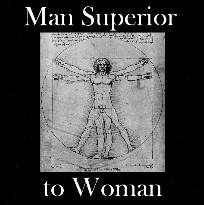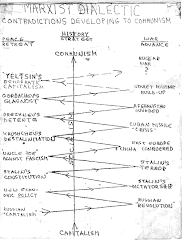.
 .
.In terms of intelligence, men and women are equal in that the average IQ of all males is equal to the average IQ of all females. There is a difference in how these equal intelligences are arrived at however.
Female intelligence is clustered around the mean far more than male intelligence. There is far less variation in female intelligence. To put it more simply, the female population’s intelligence tends to be concentrated in greater numbers around the average IQ of 100, while the male population has a greater range on both the high and low IQ scale. A far greater percentage of female IQ’s reside between 90 to 110 than males, while conversely, males inhabit the extremes of IQ between 70 to 130 in far greater percentage than females. The more you go to the extremes, the more it becomes virtually all male, in both high and low.
When one takes all of the IQ’s of the female population into account to find an average IQ, and then takes all of the IQ’s of the male population to find their average, the collective IQ’s of the two sexes are virtually identical, even though there are vast differences in their variability.
.
 .
.When one looks at “happiness,” we find the same thing as we find in intelligence.
Researchers have discovered that when they ask men to rate the periods of their lives where they feel satisfied or dissatisfied, they find that men have a major “spike” of dissatisfaction commonly known as Mid-Life Crisis.
When asking the females, what they find is that women do not have a major mid life crisis like men; however, they have several “mini” mid life crises that occur at various times in their cycle of life.
When the researchers total up all of the time in a male’s life to find his “average” happiness and compare it to the female’s average happiness throughout her life, what they find is that both males and females have almost the identical average amount of happiness in their respective lives. However, the male’s midlife crisis is far more intense than anything the typical female will ever experience – but, he only goes through it once.
.
 .
.If we look at sin, or good and evil, what would you expect to find except again the same phenomenon?
.
When a boy is bad it is very noticeable and often in the form of an outburst or some form of physical aggression. It is very hard to miss a male’s evil because its nature is overt and it occurs as a “spike.” Male aggression is stereotypically to hit, kick, shout or destroy something. The boy may go through long periods of “nothing” followed by a spike that is hard to ignore.
.
A girl, on the other hand, uses covert aggression. More commonly this is known as “Social Aggression” or “Relational Aggression” and it is stereotypically a female form of aggression. Its nature is to use gossip or social manipulation to hurt the targeted party, and this necessarily occurs over a longer period of time and is less visible than the male’s aggression.
.
What we end up seeing is that male aggression occurs as a noticeable spike that lasts only a short time while female aggression is less intense but lasts over a longer period of time. When we average out the two forms of aggression, we again will find that both male and female are equal, but different.
.
 .
.The essence of “maleness” is that things occur with infrequent but large “spikes” while the essence of “femaleness” is that things occur with more frequent but less identifiable “rhythms.” When one averages them out, men and women are equal yet they have gotten to their equal averages by different means.
Now, to the point of “equal but different,” it must also be noted that male and female sex drives are equal but different in the same manner as the above examples.
Jack Kammer, in his online book, If Men Have All The Power, How Come Women Make The Rules? said it best, so I will steal his example:
Male sexuality is like a pushy door to door salesman; it picks one target and gets in your face so much that you simply cannot ignore it.
Female sexuality, however, is like annoying junk mail. It is everywhere and steadily drones on and on at everybody, whether they are the intended target or not.
While males may think about the sex act itself more than women, the equal opposite is that women think about being “sexy” to the same degree.
.
 .
.Males and females both have equal sex drives, but they work in different ways. Even physically, men and women are equally sexual.
Men have fewer but far more intense erogenous zones, while women have erogenous zones located all over their bodies. In fact, it is fair to say that a woman’s entire body is an erogenous zone that is dispersed with lowered sexual sensitivity but over a greater area, making it equal to the man’s. This is why women are so much more into “intimacy” and the mental aspects of sex. Her entire body is involved in having sex whereas only certain, but more intense, parts of the male’s body are.
In the end of it all, men and women both have equal desires to have sex and to be sexual creatures, although they are expressed in different ways. Women have their biological clocks and get “baby rabies” that demand of them to go out and get impregnated with the same intense irrationalness that men display when they are willing to do anything to copulate with a female, including the willingness to commit treason or sell out one’s own mother.
It is horribly inaccurate for one to say that only men want sex. It is far more accurate to say that both men and women want sex equally. In fact, the only imperatives of all living things is to: 1). Survive, so that one can: 2). Reproduce. All other things are in support of these two imperatives that are universal to all living things. Males and females both have an equal desire to do this. Sex is the core of existence itself.
We may think that we humans are smarter than animals, but when it comes to sexual instinct we are animals that follow the same mating patterns as most other species in the animal kingdom.
This has become even more evident since the sexual revolution arrived and women became free from pregnancy via the pill, and free from the social stigmas associated with being a “loose” woman.
One needs only to look at studies of sexually transmitted disease by gender to see that STD’s affect a far greater percentage of the female population than the male population. There is a reason for this: 80% of the females are sleeping with 20% of the males, and those males are the alpha males in society. Humans have reverted back to the mating instincts found in most of the animal kingdom where the alpha males breed most of the females, while the beta males breed with none.
.
 .
.Again, you can see that male sexuality and female sexuality are “equal yet opposite.”
This “equal-opposite” aspect of sexuality is essential in understanding patriarchy and why things were set up in certain ways, which I will attempt to describe and explain in my next post.
Previous Index Next
MGTOW
....................
..oooO...........
..(....)...........
….\..(............
…. \_/...........
….\..(............
…. \_/...........
………....Oooo..
………....(....)…
…………..)../....
..........(_/......
………....(....)…
…………..)../....
..........(_/......
....................
------------------------------------------------------------------------------
.
Further Reading:
.
Sex, Mathematics, And Political Correctness -- by Fred Reed
Rats (Or, He Chases Her Until She Catches Him)
-----------------------------------------------------------------------------
“‘Really, women’s desire is not relational, it’s narcissictic.’ — it’s dominated by the yearnings of ‘self-love,’ by the wish to be the object of erotic admiration and sexual need. Still, on the subject of narcissism, she talked about research indicating that, in comparison with men, women’s erotic fantasies center less on giving pleasure and more on getting it. ‘When it comes to desire,’ she added, ‘women may be far less relational than men.’” -- Sex and Relationships, Bonobo Sex, and ‘Lady Boners’: Is Women’s Desire Really That Confusing? – by Vanessa Richmond
.
------------------------------------------------------------------------------
Rats (Or, He Chases Her Until She Catches Him)
-----------------------------------------------------------------------------
“‘Really, women’s desire is not relational, it’s narcissictic.’ — it’s dominated by the yearnings of ‘self-love,’ by the wish to be the object of erotic admiration and sexual need. Still, on the subject of narcissism, she talked about research indicating that, in comparison with men, women’s erotic fantasies center less on giving pleasure and more on getting it. ‘When it comes to desire,’ she added, ‘women may be far less relational than men.’” -- Sex and Relationships, Bonobo Sex, and ‘Lady Boners’: Is Women’s Desire Really That Confusing? – by Vanessa Richmond
.
------------------------------------------------------------------------------
.
From Belfort Bax's 1913 piece The Fraud of Feminism pp.25-27
.
Now let us consider the whole of the differentiations of the mental character between man and woman in the light of a further generalisation which is sufficiently obvious in itself and which has been formulated with special clearness by the late Otto Weininger in his remarkable book,"Geschlecht und Charakter" (Sex and Character). I refer to the observations contained in Section II.,Chaps. 2 and 3.
The point has been, of course, previously noted, and the present writer, among others, has on various occasions called special attention to it. But its formulation and elaboration by Weininger is the most complete I know. The truth in question consists in the fact, undeniable to all those not rendered impervious to facts by preconceived dogma, that, as I have elsewhere put it, while man has a sex, woman is a sex. Let us hear Weininger on this point. "Woman is only sexual, man is also sexual. Alike in time and space this difference may be traced in man, parts of his body susceptible to sexual excitement are small in number and strictly localised. In woman sexuality is diffused over the whole body, every contact on whatever part excites her sexually."
Weininger points out that while the sexual element in man, owing to the physio-logical character of the sexual organs, may be at times more violent than that in woman, yet that it is spasmodic and occurs in crises separated by intervals of quiescence. In woman, on the otherhand, while less spasmodic, it is continuous. The sexual instinct with man being, as he styles it, "anappendix" and no more, he can raise himself mentally entirely outside of it. "He is conscious of it as of something which he possesses but which is not inseparate from the rest of his nature. He can view it objectively. With woman this is not the case; the sex element is part of her whole nature. Hence, it is not as with man, clearly recognisable in local manifestations, but subtly affects the whole life of the organism. For this reason the man is conscious of the sexual element within him as such, whereas the woman is unconscious of it as such. It is not for nothing that in common parlance woman is spoken of as 'the sex.' In this sexual differentiation of the whole life-nature of woman from man, deducible as it is from physiological andanatomical distinctions, lies the ground of those differentiations of function which culminate in the fact that while mankind in its intellectual moral and technical development is represented in the main by Man, Woman has continued to find her chief function in the direct procreation of the race."
.
---------------------------------------------------------------------------------
.
"The central organizing principle of primate social life is competition between females and especially female lineages... Females should be, if anything, more competitive than males, not less, although the manner in which females compete may be less direct, less boisterous, and hence, more difficult to measure" -- The Woman That Never Evolved -- by Sarah Blaffer Hrdy
.
--------------------------------------------------------------------
.
“Study debunks stereotype that men think about sex all day long”
[T]he research discredits the persistent stereotype that men think about sex every seven seconds, which would amount to more than 8,000 thoughts about sex in 16 waking hours. In the study, the median number of young men’s thought about sex stood at almost 19 times per day. Young women in the study reported a median of nearly 10 thoughts about sex per day.
As a group, the men also thought about food almost 18 times per day and sleep almost 11 times per day, compared to women’s median number of thoughts about eating and sleep, at nearly 15 times and about 8 1/2 times, respectively. – Medical Xpress
(*** Please note, even though I posted this to show how stupid this meme has become, one still has to realize the way feminist researchers came to this "once every X seconds" BS is by taking the amount of hours one spends in a day thinking about such things, then dividing it by the amount of seconds in a day, and coming up with every seven or fifteen, or whatever seconds, to make it seem like men are stunted rapists thinking about sex constantly. What they are really saying is that men thought about sex for 15 minutes, multiplied by X per day (maybe three times, or six times a day), which is not surprising, and then divided the total amount of those times into how many seconds are in each day. It is totally bogus propaganda which was used to fuel the rape industry. So men think about sex for 10 minutes at a time, 8 times a day, while women think about sex 7 times a day for 5 minutes. Does that really make men into walking hardons that are looking for easy rape victims?)
--------------------------------------------------------------------
From Otto Weininger's Sex and Character, Male and Female Sexuality
"Contrary to the general opinion, there is no difference in the total sexual impulses of the sexes. However, if we examine the matter in respect to the two component forces into which Albert Moll analysed the impulse, we shall find that a difference does exist. These forces may be termed the "liberating" and the "uniting" impulses. The first appears in the form of the discomfort caused by the accumulation of ripe sexual cells; the second is the desire of the ripe individual for sexual completion. Both impulses are possessed by the male; in the female only the latter is present. The anatomy and the physiological processes of the sexes bear out the distinction.
In this connection it may be noted that only the most male youths are addicted to masturbation, and although it is often disputed, I believe that similar vices occur only among the maler of women, and are absent from the female nature.
I must now discuss the "uniting" impulse of women, for that plays the chief, if not the sole part in her sexuality. But it must not be supposed that this is greater in one sex than the other. Any such idea comes from a confusion between the desire for a thing and the stimulus towards the active part in securing what is desired. Throughout the animal and plant kingdom, the male reproductive cells are the motile, active agents, which move through space to seek out the passive female cells, and this physiological difference is sometimes confused with the actual wish for, or stimulus to, sexual union. And to add to the confusion, it happens, in the animal kingdom particularly, that the male, in addition to the directly sexual stimulus, has the instinct to pursue and bodily capture the female, whilst the latter has only the passive part to be taken possession of. These differences of habit must not be mistaken for real differences of desire.
It can be shown, moreover, that woman is sexually much more excitable (not more sensitive) physiologically than man.
The condition of sexual excitement is the supreme moment of a woman's life. The woman is devoted wholly to sexual matters, that is to say, to the spheres of begetting and of reproduction. Her relations to her husband and children complete her life, whereas the male is something more than sexual. In this respect, rather than in the relative strength of the sexual impulses, there is a real difference between the sexes. It is important to distinguish between the intensity with which sexual matters are pursued and the proportion of the total activities of life that are devoted to them and to their accessory cares. The greater absorption of the human female by the sphere of sexual activities is the most significant difference between the sexes.
The female, moreover, is completely occupied and content with sexual matters, whilst men are interested in much else, in war and sport, in social affairs and feasting, in philosophy and science, in business and politics, in religion and art. I do not mean to imply that this difference has always existed, as I do not think that important. As in the case of the Jewish question, it may be said that the Jews have their present character because it has been forced upon them, and that at one time they were different. It is now impossible to prove this, and we may leave it to those who believe in the modification by the environment to accept it. The historical evidence is equivocal on the point. In the question of women, we have to take people as they exist today. If, however, we happen to come on attributes that could not possibly have been grafted on them from without, we may believe that such have always been with them. Of contemporary women at least one thing is certain. Apart from an exception to be noted in chap. xii, it is certain that when the female occupies herself with matters outside the interests of sex, it is for the man that she loves or by whom she wishes to be loved. She takes no real interest in things themselves. It may happen that a real female learns Latin; if so, it is for some such purpose as to help her son who is at school. Desire for a subject and ability for it, interest in it, and the facility for acquiring it, are usually proportional. He who has slight muscles has no desire to wield an axe; those without the faculty for mathematics do not desire to study that subject. Talent seems to be rare and feeble in the real female (although possibly it is merely that the dominant sexuality prevents its development), with the result that woman has no power of forming the combinations which, although they do not actually make the individuality, certainly shape it.
Corresponding to true women, there are extremely female men who are to be found always in the apartments of the women, and who are interested in nothing but love and sexual matters. Such men, however, are not the Don Juans.
The female principle is, then, nothing more than sexuality; the male principle is sexual and something more. This difference is notable in the different way in which men and women enter the period of puberty. In the case of the male the onset of puberty is a crisis; he feels that something new and strange has come into his being, that something has been added to his powers and feelings independently of his will. The physiological stimulus to sexual activity appears to come from outside his being, to be independent of his will, and many men remember the disturbing event throughout their after lives. The woman, on the other hand, not only is not disturbed by the onset of puberty, but feels that her importance has been increased by it. The male, as a youth, has no longing for the onset of sexual maturity; the female, from the time when she is still quite a young girl, looks forward to that time as one from which everything is to be expected. Man's arrival at maturity is frequently accompanied by feelings of repulsion and disgust; the young female watches the development of her body at the approach of puberty with excitement and impatient delight. It seems as if the onset of puberty were a side path in the normal development of man, whereas in the case of woman it is the direct conclusion. There are few boys approaching puberty to whom the idea that they would marry (in the general sense, not a particular girl) would not appear ridiculous, whilst the smallest girl is almost invariably excited and interested in the question of her future marriage. For such reasons a woman assigns positive value only to her period of maturity in her own case and that of other women; in childhood, as in old age, she has no real relation to the world. The thought of her childhood is for her, later on, only the remembrance of her stupidity; she faces the approach of old age with dislike and abhorrence. The only real memories of her childhood are connected with sex, and these fade away in the intensely greater significance of her maturity. The passage of a woman from virginity is the great dividing point of her life, whilst the corresponding event in the case of a male has very little relation to the course of his life.
Woman is only sexual, man is partly sexual, and this difference reveals itself in various ways. The parts of the male body by stimulation of which sexuality is excited are limited in area, and are strongly localised, whilst in the case of the woman, they are diffused over her whole body, so that stimulation may take place almost from any part. When in the second chapter of Part I., I explained that sexuality is distributed over the whole body of both sexes, I did not mean that, therefore, the sense organs, through which the definite impulses are stimulated, were equally distributed. There are, certainly, areas of greater excitability, even in the case of the woman, but there is not, as in the man, a sharp division between the sexual areas and the body generally.
The morphological isolation of the sexual area from the rest of the body in the case of man, may be taken as symbolical of the relation of sex to his whole nature. Just as there is a contrast between the sexual and the sexless parts of a man's body, so there is a time-change in his sexuality. The female is always sexual, the male is sexual only intermittently. The sexual instinct is always active in woman (as to the apparent exceptions to this sexuality of women, I shall have to speak later on), whilst in man it is at rest from time to time. And thus it happens that the sexual impulse of the male is eruptive in character and so appears stronger. The real difference between the sexes is that in the male the desire is periodical, in the female continuous.
This exclusive and persisting sexuality of the female has important physical and psychical consequences. As the sexuality of the male is an adjunct to his life, it is possible for him to keep it in the physiological background, and out of his consciousness. And so a man can lay aside his sexuality and not have to reckon with it. A woman has not her sexuality limited to periods of time, nor to localised organs. And so it happens that a man can know about his sexuality, whilst a woman is unconscious of it and can in all good faith deny it, because she is nothing but sexuality, because she is sexuality itself.
It is impossible for women, because they are only sexual to recognise their sexuality, because recognition of anything requires duality. With man it is not only that he is not merely sexual, but anatomically and physiologically he can "detach" himself from it. That is why he has the power to enter into whatever sexual relations he desires; if he likes he can limit or increase such relations; he can refuse or assent to them. He can play the part of a Don Juan or a monk. He can assume which he will. To put it bluntly, man possesses sexual organs; her sexual organs possess woman.
We may, therefore, deduce from the previous arguments that man has the power of consciousness of his sexuality and so can act against it, whilst the woman appears to be without this power. This implies, moreover, that there is greater differentiation in man, as in him the sexual and the unsexual parts of his nature are sharply separated. The possibility or impossibility of being aware of a particular definite object is, however, hardly a part of the customary meaning of the word consciousness, which is generally used as implying that if a being is conscious he can be conscious of any object. This brings me to consider the nature of the female consciousness."
.
---------------------------------------------------------------------------------
.
"The central organizing principle of primate social life is competition between females and especially female lineages... Females should be, if anything, more competitive than males, not less, although the manner in which females compete may be less direct, less boisterous, and hence, more difficult to measure" -- The Woman That Never Evolved -- by Sarah Blaffer Hrdy
.
--------------------------------------------------------------------
.
“Study debunks stereotype that men think about sex all day long”
[T]he research discredits the persistent stereotype that men think about sex every seven seconds, which would amount to more than 8,000 thoughts about sex in 16 waking hours. In the study, the median number of young men’s thought about sex stood at almost 19 times per day. Young women in the study reported a median of nearly 10 thoughts about sex per day.
As a group, the men also thought about food almost 18 times per day and sleep almost 11 times per day, compared to women’s median number of thoughts about eating and sleep, at nearly 15 times and about 8 1/2 times, respectively. – Medical Xpress
(*** Please note, even though I posted this to show how stupid this meme has become, one still has to realize the way feminist researchers came to this "once every X seconds" BS is by taking the amount of hours one spends in a day thinking about such things, then dividing it by the amount of seconds in a day, and coming up with every seven or fifteen, or whatever seconds, to make it seem like men are stunted rapists thinking about sex constantly. What they are really saying is that men thought about sex for 15 minutes, multiplied by X per day (maybe three times, or six times a day), which is not surprising, and then divided the total amount of those times into how many seconds are in each day. It is totally bogus propaganda which was used to fuel the rape industry. So men think about sex for 10 minutes at a time, 8 times a day, while women think about sex 7 times a day for 5 minutes. Does that really make men into walking hardons that are looking for easy rape victims?)
--------------------------------------------------------------------
From Otto Weininger's Sex and Character, Male and Female Sexuality
"Contrary to the general opinion, there is no difference in the total sexual impulses of the sexes. However, if we examine the matter in respect to the two component forces into which Albert Moll analysed the impulse, we shall find that a difference does exist. These forces may be termed the "liberating" and the "uniting" impulses. The first appears in the form of the discomfort caused by the accumulation of ripe sexual cells; the second is the desire of the ripe individual for sexual completion. Both impulses are possessed by the male; in the female only the latter is present. The anatomy and the physiological processes of the sexes bear out the distinction.
In this connection it may be noted that only the most male youths are addicted to masturbation, and although it is often disputed, I believe that similar vices occur only among the maler of women, and are absent from the female nature.
I must now discuss the "uniting" impulse of women, for that plays the chief, if not the sole part in her sexuality. But it must not be supposed that this is greater in one sex than the other. Any such idea comes from a confusion between the desire for a thing and the stimulus towards the active part in securing what is desired. Throughout the animal and plant kingdom, the male reproductive cells are the motile, active agents, which move through space to seek out the passive female cells, and this physiological difference is sometimes confused with the actual wish for, or stimulus to, sexual union. And to add to the confusion, it happens, in the animal kingdom particularly, that the male, in addition to the directly sexual stimulus, has the instinct to pursue and bodily capture the female, whilst the latter has only the passive part to be taken possession of. These differences of habit must not be mistaken for real differences of desire.
It can be shown, moreover, that woman is sexually much more excitable (not more sensitive) physiologically than man.
The condition of sexual excitement is the supreme moment of a woman's life. The woman is devoted wholly to sexual matters, that is to say, to the spheres of begetting and of reproduction. Her relations to her husband and children complete her life, whereas the male is something more than sexual. In this respect, rather than in the relative strength of the sexual impulses, there is a real difference between the sexes. It is important to distinguish between the intensity with which sexual matters are pursued and the proportion of the total activities of life that are devoted to them and to their accessory cares. The greater absorption of the human female by the sphere of sexual activities is the most significant difference between the sexes.
The female, moreover, is completely occupied and content with sexual matters, whilst men are interested in much else, in war and sport, in social affairs and feasting, in philosophy and science, in business and politics, in religion and art. I do not mean to imply that this difference has always existed, as I do not think that important. As in the case of the Jewish question, it may be said that the Jews have their present character because it has been forced upon them, and that at one time they were different. It is now impossible to prove this, and we may leave it to those who believe in the modification by the environment to accept it. The historical evidence is equivocal on the point. In the question of women, we have to take people as they exist today. If, however, we happen to come on attributes that could not possibly have been grafted on them from without, we may believe that such have always been with them. Of contemporary women at least one thing is certain. Apart from an exception to be noted in chap. xii, it is certain that when the female occupies herself with matters outside the interests of sex, it is for the man that she loves or by whom she wishes to be loved. She takes no real interest in things themselves. It may happen that a real female learns Latin; if so, it is for some such purpose as to help her son who is at school. Desire for a subject and ability for it, interest in it, and the facility for acquiring it, are usually proportional. He who has slight muscles has no desire to wield an axe; those without the faculty for mathematics do not desire to study that subject. Talent seems to be rare and feeble in the real female (although possibly it is merely that the dominant sexuality prevents its development), with the result that woman has no power of forming the combinations which, although they do not actually make the individuality, certainly shape it.
Corresponding to true women, there are extremely female men who are to be found always in the apartments of the women, and who are interested in nothing but love and sexual matters. Such men, however, are not the Don Juans.
The female principle is, then, nothing more than sexuality; the male principle is sexual and something more. This difference is notable in the different way in which men and women enter the period of puberty. In the case of the male the onset of puberty is a crisis; he feels that something new and strange has come into his being, that something has been added to his powers and feelings independently of his will. The physiological stimulus to sexual activity appears to come from outside his being, to be independent of his will, and many men remember the disturbing event throughout their after lives. The woman, on the other hand, not only is not disturbed by the onset of puberty, but feels that her importance has been increased by it. The male, as a youth, has no longing for the onset of sexual maturity; the female, from the time when she is still quite a young girl, looks forward to that time as one from which everything is to be expected. Man's arrival at maturity is frequently accompanied by feelings of repulsion and disgust; the young female watches the development of her body at the approach of puberty with excitement and impatient delight. It seems as if the onset of puberty were a side path in the normal development of man, whereas in the case of woman it is the direct conclusion. There are few boys approaching puberty to whom the idea that they would marry (in the general sense, not a particular girl) would not appear ridiculous, whilst the smallest girl is almost invariably excited and interested in the question of her future marriage. For such reasons a woman assigns positive value only to her period of maturity in her own case and that of other women; in childhood, as in old age, she has no real relation to the world. The thought of her childhood is for her, later on, only the remembrance of her stupidity; she faces the approach of old age with dislike and abhorrence. The only real memories of her childhood are connected with sex, and these fade away in the intensely greater significance of her maturity. The passage of a woman from virginity is the great dividing point of her life, whilst the corresponding event in the case of a male has very little relation to the course of his life.
Woman is only sexual, man is partly sexual, and this difference reveals itself in various ways. The parts of the male body by stimulation of which sexuality is excited are limited in area, and are strongly localised, whilst in the case of the woman, they are diffused over her whole body, so that stimulation may take place almost from any part. When in the second chapter of Part I., I explained that sexuality is distributed over the whole body of both sexes, I did not mean that, therefore, the sense organs, through which the definite impulses are stimulated, were equally distributed. There are, certainly, areas of greater excitability, even in the case of the woman, but there is not, as in the man, a sharp division between the sexual areas and the body generally.
The morphological isolation of the sexual area from the rest of the body in the case of man, may be taken as symbolical of the relation of sex to his whole nature. Just as there is a contrast between the sexual and the sexless parts of a man's body, so there is a time-change in his sexuality. The female is always sexual, the male is sexual only intermittently. The sexual instinct is always active in woman (as to the apparent exceptions to this sexuality of women, I shall have to speak later on), whilst in man it is at rest from time to time. And thus it happens that the sexual impulse of the male is eruptive in character and so appears stronger. The real difference between the sexes is that in the male the desire is periodical, in the female continuous.
This exclusive and persisting sexuality of the female has important physical and psychical consequences. As the sexuality of the male is an adjunct to his life, it is possible for him to keep it in the physiological background, and out of his consciousness. And so a man can lay aside his sexuality and not have to reckon with it. A woman has not her sexuality limited to periods of time, nor to localised organs. And so it happens that a man can know about his sexuality, whilst a woman is unconscious of it and can in all good faith deny it, because she is nothing but sexuality, because she is sexuality itself.
It is impossible for women, because they are only sexual to recognise their sexuality, because recognition of anything requires duality. With man it is not only that he is not merely sexual, but anatomically and physiologically he can "detach" himself from it. That is why he has the power to enter into whatever sexual relations he desires; if he likes he can limit or increase such relations; he can refuse or assent to them. He can play the part of a Don Juan or a monk. He can assume which he will. To put it bluntly, man possesses sexual organs; her sexual organs possess woman.
We may, therefore, deduce from the previous arguments that man has the power of consciousness of his sexuality and so can act against it, whilst the woman appears to be without this power. This implies, moreover, that there is greater differentiation in man, as in him the sexual and the unsexual parts of his nature are sharply separated. The possibility or impossibility of being aware of a particular definite object is, however, hardly a part of the customary meaning of the word consciousness, which is generally used as implying that if a being is conscious he can be conscious of any object. This brings me to consider the nature of the female consciousness."



















































